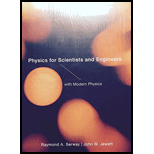
(a)
The proof that the electron would be in equilibrium at the centre and if displaced from the centre with distance
(a)
Answer to Problem 62CP
The electron is in equilibrium at the centre of the Gaussian sphere and when the electron is at
Explanation of Solution
Write the expression to obtain the charge density.
Here,
Substitute
Write the expression for the charge enclosed in the Gaussian sphere.
Here,
Substitute,
Write the expression on the basis of Gauss law.
Re-write the above equation.
Here,
Substitute
Write the expression to obtain the force in the Gaussian surface.
Here,
Substitute
Substitute
Here,
Further substitute,
Substitute,
Therefore, the electron is in equilibrium at the centre of the Gaussian sphere and when the electron is at
(b)
The proof that the value of
(b)
Answer to Problem 62CP
The value of
Explanation of Solution
Compare equation (I) and (II).
Therefore, the value of
(c)
The expression for the frequency of a simple harmonic oscillator.
(c)
Answer to Problem 62CP
The frequency of a simple harmonic oscillator is
Explanation of Solution
Write the expression of force based on Newton’s
Here,
Substitute,
Write the expression to simple harmonic wave equation.
Here,
Compare equation (III) and (IV).
Write the expression for the frequency of the simple harmonic motion.
Here,
Substitute,
Therefore, the frequency of the simple harmonic motion is
(d)
The radius of the orbit.
(d)
Answer to Problem 62CP
The radius of the orbit is
Explanation of Solution
Re-write the equation (V).
Substitute
Solve the above equation
Take square both the sides.
Conclusion:
Substitute,
Therefore, the radius of the orbit is
Want to see more full solutions like this?
Chapter 24 Solutions
Physics For Scientists And Engineers With Modern Physics, 9th Edition, The Ohio State University
- No chatgpt plsarrow_forwardhelp me with the experimental set up for the excel i did. the grapharrow_forwardWhich of the following best describes how to calculate the average acceleration of any object? Average acceleration is always halfway between the initial acceleration of an object and its final acceleration. Average acceleration is always equal to the change in velocity of an object divided by the time interval. Average acceleration is always equal to the displacement of an object divided by the time interval. Average acceleration is always equal to the change in speed of an object divided by the time interval.arrow_forward
- The figure shows the velocity versus time graph for a car driving on a straight road. Which of the following best describes the acceleration of the car? v (m/s) t(s) The acceleration of the car is negative and decreasing. The acceleration of the car is constant. The acceleration of the car is positive and increasing. The acceleration of the car is positive and decreasing. The acceleration of the car is negative and increasing.arrow_forwardWhich figure could represent the velocity versus time graph of a motorcycle whose speed is increasing? v (m/s) v (m/s) t(s) t(s)arrow_forwardUnlike speed, velocity is a the statement? Poisition. Direction. Vector. Scalar. quantity. Which one of the following completesarrow_forward
- No chatgpt pls will upvote Already got wrong chatgpt answerarrow_forward3.63 • Leaping the River II. A physics professor did daredevil stunts in his spare time. His last stunt was an attempt to jump across a river on a motorcycle (Fig. P3.63). The takeoff ramp was inclined at 53.0°, the river was 40.0 m wide, and the far bank was 15.0 m lower than the top of the ramp. The river itself was 100 m below the ramp. Ignore air resistance. (a) What should his speed have been at the top of the ramp to have just made it to the edge of the far bank? (b) If his speed was only half the value found in part (a), where did he land? Figure P3.63 53.0° 100 m 40.0 m→ 15.0 marrow_forwardPlease solve and answer the question correctly please. Thank you!!arrow_forward
 Principles of Physics: A Calculus-Based TextPhysicsISBN:9781133104261Author:Raymond A. Serway, John W. JewettPublisher:Cengage Learning
Principles of Physics: A Calculus-Based TextPhysicsISBN:9781133104261Author:Raymond A. Serway, John W. JewettPublisher:Cengage Learning Physics for Scientists and Engineers: Foundations...PhysicsISBN:9781133939146Author:Katz, Debora M.Publisher:Cengage Learning
Physics for Scientists and Engineers: Foundations...PhysicsISBN:9781133939146Author:Katz, Debora M.Publisher:Cengage Learning University Physics Volume 1PhysicsISBN:9781938168277Author:William Moebs, Samuel J. Ling, Jeff SannyPublisher:OpenStax - Rice University
University Physics Volume 1PhysicsISBN:9781938168277Author:William Moebs, Samuel J. Ling, Jeff SannyPublisher:OpenStax - Rice University
 Physics for Scientists and Engineers with Modern ...PhysicsISBN:9781337553292Author:Raymond A. Serway, John W. JewettPublisher:Cengage Learning
Physics for Scientists and Engineers with Modern ...PhysicsISBN:9781337553292Author:Raymond A. Serway, John W. JewettPublisher:Cengage Learning Physics for Scientists and Engineers, Technology ...PhysicsISBN:9781305116399Author:Raymond A. Serway, John W. JewettPublisher:Cengage Learning
Physics for Scientists and Engineers, Technology ...PhysicsISBN:9781305116399Author:Raymond A. Serway, John W. JewettPublisher:Cengage Learning





